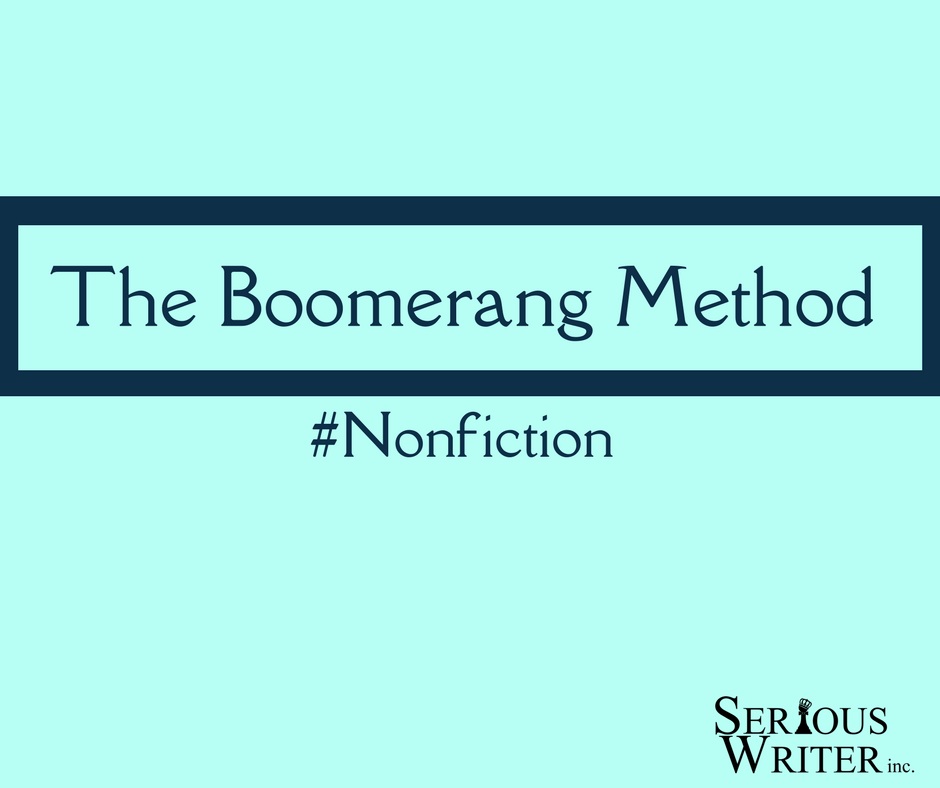
The Nonfiction Boomerang Method
Writing nonfiction carries a promise to the reader that not only extends to the book as a whole, but also within chapters, and to be nitty gritty, the sub-headings as well.
If you pick up a book called “Get Out of Debt in Six Months or Less,” you expect the author to share tips and strategies to do just that. Inside of Chapter One, titled “Sell Everything You Own and Live in a Van Down By the River,” the author is promising to share not only how to significantly reduce your possessions, but how to relocate to a waterside location.
If the author talks about reducing credit card debt in this chapter, a promise has been broken and subconsciously, the trust factor wanes.
Introducing the Boomerang Method
After you’ve written your first draft (remember, Stephen King says that first one is just for you) you get to play with the content. Move it around. Delete it. Add subheadings. Fill in gaps. And make sure that everything you’re talking about in the chapter relates back to the promise of the chapter.
It must boomerang.
The chapter title, subtitle, and opening lines throw out the promise…and the rest of the content strengthens and explains that promise by always relating it back. Boomerang!
As the author, you set the tone and parameters for your topic and your audience reads in good faith that you’re going to provide them value. One of the biggest mistakes we make as authors is trying to cram too much information into our articles, posts, or chapters. When we overdo, we aren’t digging deeper into the content, instead, we’re only scraping the surface like a rake across a zen garden.
This is easily understood when it comes to chapter content with clear boundaries. In my dating guide, the chapters on Red Flags, Kissing, and Modesty may have had a little bit of crossover, but not much. It was easy to know which stories went in each chapter and which tips and dating rules to include in each.
The trickier part was making sure that the subheadings were always appropriate within each chapter. Guidelines on how to navigate the engagement months didn’t boomerang to the promise given in the chapter called Confidence, and so on.
Self-Editing
This may seem like we’re focusing on extremely nit-picky details, but I believe this is one of the marks of great writing. The next time you’re editing your work, look at sections inside your chapters. Are you relating everything back to the specific topic at hand? Are you giving information without explaining to your reader why it needed to be in this specific chapter?
I’ll admit this is one of the hardest parts of self-editing for my own work, and it’s often the feedback I’m looking for with my first readers.
Every story matters.
Every word matters.
Grab your coffee, your water bottle, or whatever drink is closest to you and raise it with me. Here’s to great writing and high standards. Cheers.
Bethany Jett is the Co-Owner of Serious Writer, Inc., and Vice President of Platinum Literary Services where she specializes in marketing, nonfiction proposal creation, ghostwriting, and developmental editing. Her love for email funnels and social media led to her pursuing her Master of Fine Arts degree in Communication with an emphasis in marketing and public relations.
Bethany is a military spouse, momma-of-boys, suspense-novel junkie who describes herself as “mid-maintenance” and loves cute shoes and all things girly. She blogs at BethanyJett.com on living a brilliant life. Take the free 30-Day #LiveBrilliant Challenge and check out her “21 Trade Secrets and Best Practices” course over at SeriousWriterAcademy.com.

